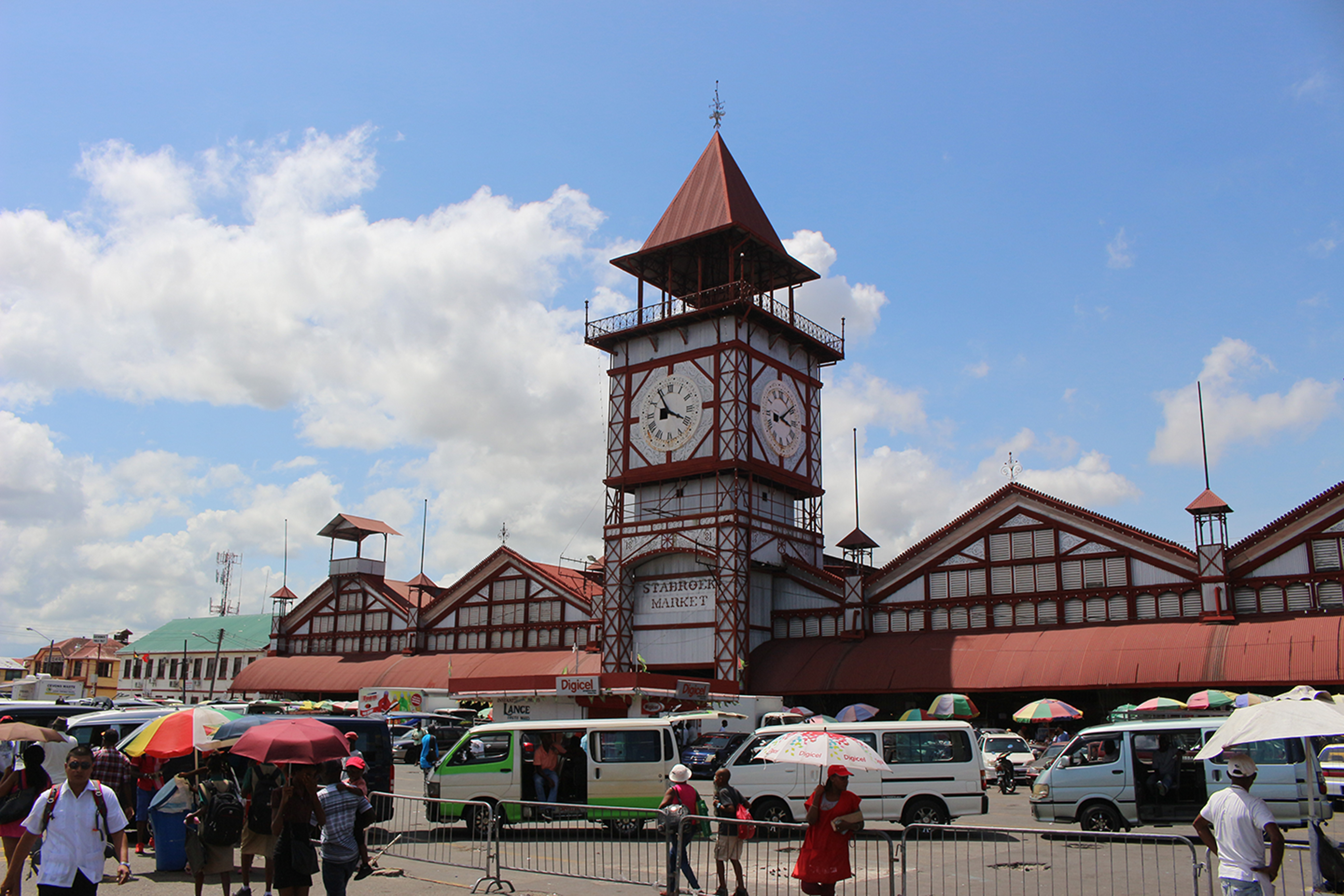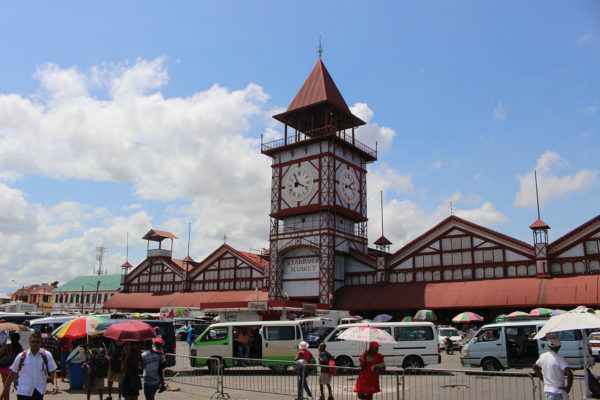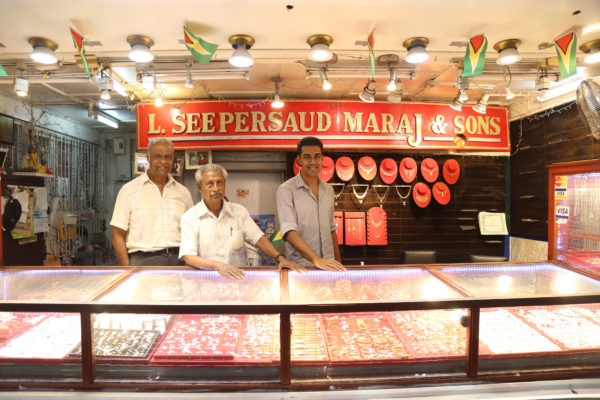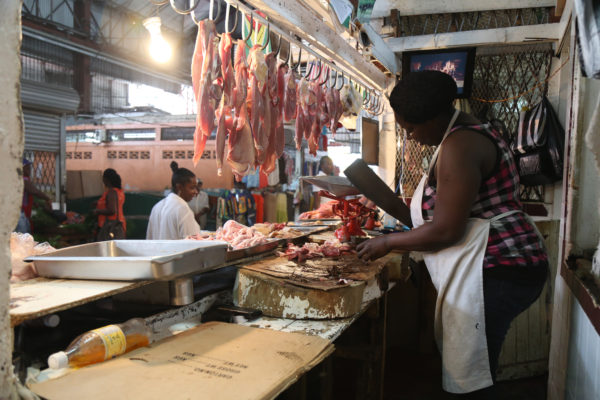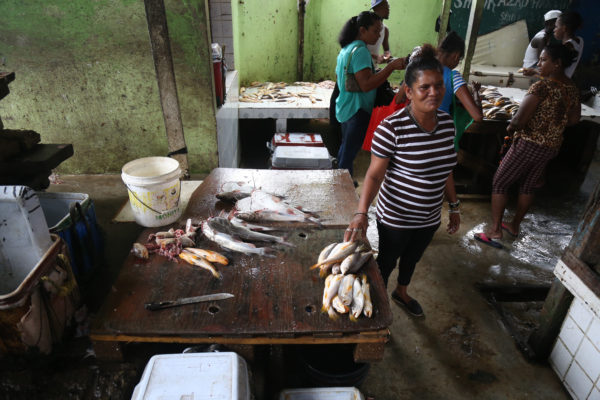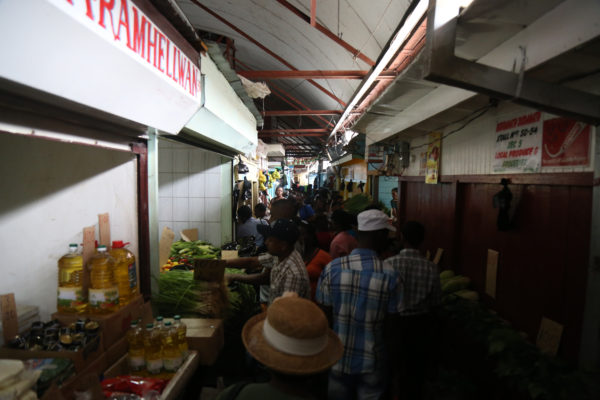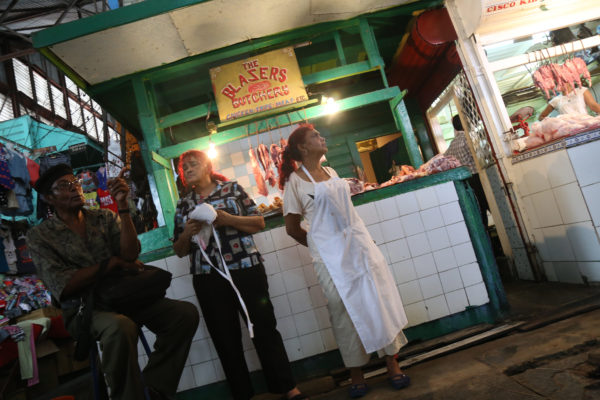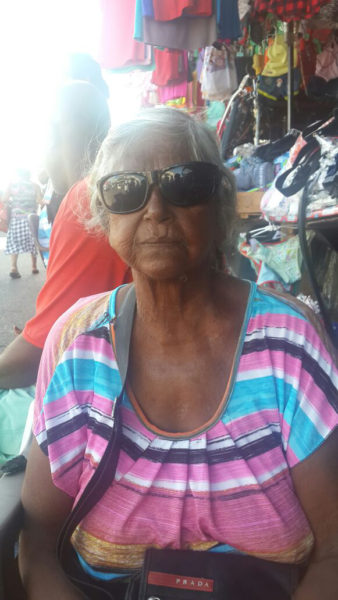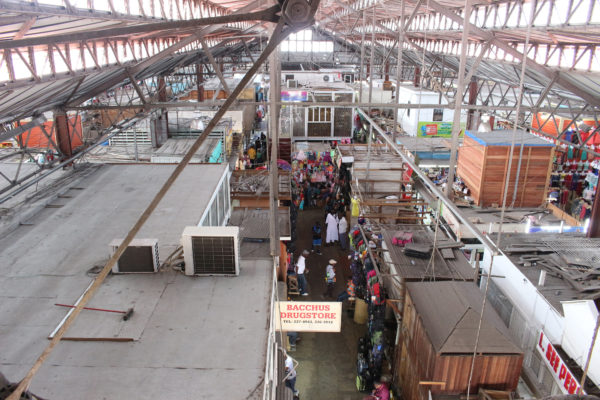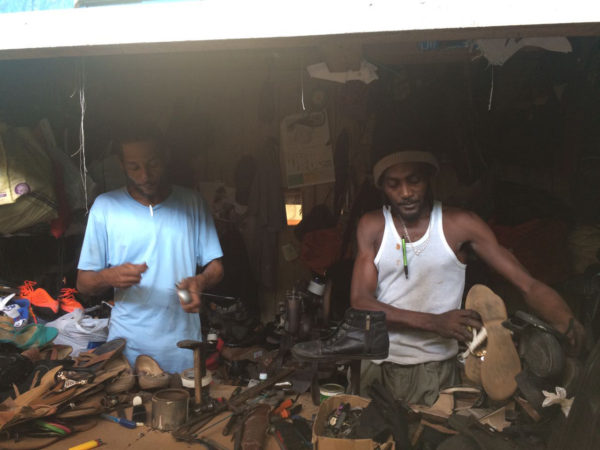(As part of its 30th anniversary being observed today, Stabroek News revisited the Stabroek Market for which it is named and spoke to some of its stallholders)
For 135 years, the Stabroek Market, with its peaked clock tower and steel-framed structure has sat at the edge of the Demerara River, hovering over downtown Georgetown like a prayer.
It is a meeting place; a synergy of subcultures. An inheritance passed from generation to stall-holding generation.
They have inherited the trade, whether it has been passed down or sold. What many have acquired is an heirloom, aged and valued with time. While tourists and locals alike can enjoy the view from the famous clock tower, the clock itself no longer functions. Vendors recollected the days when the clock would chime every hour on the hour, and once at half-hour intervals. Back then, watches were few as they were expensive to own. Now, everyone moves at his own pace.
“The market is the Guyanese experience. It is a good representation of the Guyanese culture. It’s about everyone trying to make a dollar, it’s about honest living and everybody going about their motives,” Vead Persaud, of L. Seepersaud Maraj and Sons stated.
“The market is a local flair; you could see everything, you could hear everything,” Ram Maraj stated. His family’s business has formed a part of the Stabroek Market’s legacy for the past 81 years.
He referred to the Stabroek Market as Guyana’s first traditional mall, noting that one could find “from a pin to an anchor.” He described it as a natural meeting point, one where many converge while going about their daily activities for shopping, for transport, to meet up with a colleague or lover.
The market is symmetry; its steel frame bearing parallel lines of concrete aisles and a high ceiling boasting complexly placed metal beams.
The aisles converge to form grids, and aside from the structured design, at first glance, there seems to be little thought to the order of business: Mere steps away from the butchery is a clothing stall dresses and shirts and pants are on show while, a few feet away, cuts of meat lie out on display. There is a jewellery store, then an electronics store. At the back, there is a man selling birds across from his shoe vending neighbour. In the middle, a book stall lies like an island in a sea of clothing vendors.
Little has changed over the past few decades in terms of the market’s organisation, however, said Maraj, co-owner of L Seepersaud Maraj and Sons.
The family’s jewellery business has claimed its place near the front of the Stabroek Market since 1935; and the shoe repairmen and cloth vendors have always been at the back of the market; and the fish pond has always existed where it exists now; but the area to the far right of the market, near the gate, where ice was once sold has been replaced by a grocery stall; and the clerk of markets no longer occupies the office overlooking the bazaar but now does business from a building near the wharf; and although clothing stalls were a now blossoming enterprise in the 80s, they now seem to account for a significant chunk of vending activity.
The cart men, who one vendor related used to be located at the wharf, have taken up their places closer to the grocery stalls, where they are hired by the proprietors to transport bulk goods to and from the stores at a service cost of between $200 and $500.
The now rising trade, Ram believes, is electronics. A few cellphone and electronic stalls have bought over more traditional shops, like snackettes.
Reinvention
Ram noted that among the changes was the need for adaptation. Many vendors have had to alter their trade to suit the changing trends. For the Maraj family, that meant creating jewellery that fit the newly emerging tastes, although this does not mean that the older styles of jewellery were phased out completely.
For Seeram Lall, who has been vending for 40 plus years, the ban on goods during the 80s by the government of the day forced him to reinvent his business.
Lall had been a grocer, but changed to bird vending after access to imported goods became limited. In the 80s, Stabroek vendors still managed to bring in contraband goods from traders who travelled to territories in and around the Caribbean, including Suriname and Venezuela and further afield to Brazil. Listed among the prohibited items were margarine, onions and canned goods such as peas. It seems almost preposterous now to think that such items, which now crowd the shelves of a number of grocery stalls, were once bought illegally and sold at elevated prices. Lall now sells the towa towa, commonly known as `Bastard’ and the twa twa bird. The man related that they are transported to Georgetown from the Rupununi and sold at a starting price of $7,000 or $8,000.
Speaking on conditions in the market, Lall said that the only problem faced by the vendors in his area had been flooding, but that issue was dealt with by the stall holders.
“Only problem was water flooding but council said they have no money so vendors spend to have the area built up…Not everything ya goh depend on people ya know. Ya gotta help yaself, right?” Lall commented.
The daily hustle
There are no predetermined good days or bad days when it comes to sales, there is only a schedule the market opens at 7 am and closes at 5pm. Every third Wednesday the stallholders operate for half day to facilitate the market’s cleaning.
Maraj stated that back in the 60s Saturdays would be busy market days because persons would travel all the way from MacKenzie.
“Shopping now depends on how people get money, that’s how it is,” Esther, a butcher, commented.
Many vendors concede that business activity has slowed significantly. A few express the view that this is the result of a rise in the number of supermarkets around town and an increase in commercial activity by Chinese immigrants, who sell goods at reduced prices. This coupled with the fact that there has been an increase in the number of vendors at the bazaar.
There are complaints from all around the fruit vendors complain, the grocery vendors complain; the cook shop vendors seem to be less dependent on the produce of their fellow stall holders; one fishmonger speculates that the flow may be the result of a lack of spending power. The butchers complain, even the cart men complain. “Don’t let nobody tell yuh business good,” one cart pusher admonished.
“Couple years ago business was good then cause we ain had all them supermarkets and fish wah done clean and so, so we used to get the customers. And now supermarkets supplying them with it done cleaned and seasoned and so ya know…only who need fresh ketch is come here,” Asha Khan, a fish vendor stated.
It is hard, some fruit vendors say. Even inside the market itself. “Whole day ya sit down, ya na sell $20” one woman cried. She has been vending for 38 years but relocated from the Stabroek Market wharf to the outside of the market after it became dilapidated.
Another fruit vendor related that “market slow, slow, slow,” complaining that her produce is often left to spoil. She, a vendor of more than 30 years, sells sweet fig bananas because that is what is in season at the moment.
The wharf
Behind the market lies the wharf, now a fragile thing; planks grown weary; distant. Waiting to collapse into the murky depths below. It has lost its tenants to the more stable pavement outside, where vendors are permitted to sell their provisions from 3pm to 6pm, Monday through Saturday at a charge of $300 daily. There, fruit and provision vendors line the roadway paralleling the fence.
While some vendors ply their trade on the wharf during the morning and early afternoon hours, they leave the wharf at 3:00pm to vend outside. One woman, who wished not to be named, said that she herself only comes out to sell from the 3:00 hour.
The challenge, she related, is having to pay daily for the opportunity to vend when some days much profit is not reaped.
In the afternoons, retailers, some of them farmers, come with produce to supply the market vendors for the next day; but a threat arises: patrons, able to eliminate the middle man, can purchase goods much cheaper and take advantage of this.
The goods come from the highway and Linden and Canal on the West Demerara, among other places. One vendor says that most of her produce comes from the Pomeroon but she also purchases goods from those same suppliers who pass through the market every foreday morning.
The fish pond
When you leave the Western gate of the Stabroek Market you enter a valley of citrus. The scent pierces the air, the passageway so lined with fruit and vegetable stalls.
Walk north and the smell dissipates. There is no smooth transition. The air, in sudden urgency, assumes a pungent odour and soon after, you find yourself at the fish pond.
The fish pond is an enclosed area where the day’s catch is sold. Fish are displayed on long, wooden tables, and decorated with citrus peels and peppers, reportedly to keep flies away.
Trout, Bangamary, Cuirass, Cuffum, annafoka and shrimp, are just some of the options available. The fish are bought at the Meadowbank wharf, as early as 3am and then brought to the Stabroek Market, where vending begins when the gates open at 7am.
Khan, a vendor of 18 years, says her customers frequently request Cuirass on the doctors’ orders. Bangamary is also popular because it is widely liked. According to another fishmonger, Jacqueline Backer, annafoka is popular for barbeques and grilling. Backer also related that the fish guts are usually sold to persons for use as bait or for pig feed.
Thirty years ago, there was no access to water in this area for washing or drinking, but now, the fishmongers have water access via a pipe stand placed just a few feet outside the gate. They wash the area daily.
The meat centre
The butcher section offers a variety of meats including saltfish, eggs, tripe, pork, duck and mutton, but beef and chicken are the most in demand.
The supplies of beef come from the abattoir and the west side, the vendors report, while chicken is supplied by Mohammed’s farm, Bounty and other private suppliers.
One butcher, Sharon, who has been vending in the market since she was 10 years old, and whose business was passed down from her grandfather to her aunt and cousins and then uncle and herself, noted her concern over the location of the meat centre.
“For instance, this stall here, this is a meat centre, this is a shoe stall, this not suspposed to be here. Next thing, when rain fall, ya sit down right here you getting wet. All angle.”
She opined that the “brightest business” is around the Christmas season and “one and two Saturdays when workers get paid.”
Another vendor there, Sabo, who has been vending for 19 years, said the busiest days are Saturdays and sometimes Fridays, but acknowledged that sales are not as before.
“Market was busier back then, business is slow because there are a lot of meat businesses that also sell dog meat. Dog meat was selling back then but not like now, Sabo said, adding, “Dog meat is the going thing now.”
At the butchery, like the fish pond, nothing is wasted; everything is sold. The waste bones from cow head, and the neck, wings and feet of chicken are sold for dog food.
Security
Security is of major concern at the Stabroek Market. According to the city constabulary, the market has become a haven for criminal activity.
Loiterers have taken to hanging in the passageways, crowding the main gates and standing in groups under the market’s clock.
More foot patrolling is needed, one vendor opined, stating that laws are not enforced like they used to be. Restrictions like no running, no quarreling and no alcohol are things of the past.
Rajpatie Sudial
Between the years of 1965 and 1966, Rajpatie Sudial, commonly referred to as “Sista,” now 74 years old, began vending at the Stabroek Market.
Her trade began inside its gates, where she first assisted a shoe vendor, then a woman with a cloth stand, before venturing beneath the clock on April 9th, 1978, where she has remained until today.
Sudial sells shoes now. She relates that sales do not thrive as much recently, not like earlier this year and certainly not like years past. Leather and rubber slippers decorate the cardboard cutouts placed atop a quantity of elevated surfaces. This setup (shoes included) is replicated in many of the stalls beneath the clock of the Stabroek Market.
She relates that she has been out since 5am, according to routine, to beat the heat of the 6’o clock sun. Even so, when at 2 pm she is asked about her sales for the day, she responds “not many,” and her reply is followed by a burst of laughter. “But thank God for whatever, you know, whatever, I thank God for it,” the elderly woman adds.
Across the way, a cart man advertises cold cane juice. Nearby, a man sells locks and knives openly on a stand as people walk by nonchalantly.
Heirloom
Sudial’s neighbour to the left is Carol Carter. Carter, 52, is the Vice-President of the Market Vendors Union.
Also a shoe vendor by trade, the stall Carol runs was passed down to her from her father, who had had it passed down to him by his grandmother, Mildred.
Mildred Carter sold fruits, but the use of her stall changed as the stall’s ownership changed hands. Her grandson, Compton Carter, Carol’s father, had sold confectionaries in his time.
“That market there, my grandmother gave me the stall because she brought me up there and she was a stall holder and it mind me. It in turn now mind my wife and my children and I do hope that when I leave this earth that my children will continue and pass it on,” Compton expressed, adding that selling in the market had been very enjoyable.
Compton, now 76, spends his days on the tarmac of Qik Serv, opposite the Stabroek Market Square, where he sells video games. He related that he sold DVDs previously, but switched focus because he prefers not to have competition. This, notwithstanding the fact that there is not much demand for the items he is offering.
The elderly man is confined to a wheelchair, having had his legs amputated a few years ago following an accident. Although he spent most of his life in the Stabroek Market at the knees of his grandmother, it has been three years since he has ventured inside its gates.
“The body is willing but my spirit is not,” he explained. “I don’t have the spirit to go there. The spirit is telling me don’t go there and I don’t.”
Compton noted that the market has changed quite a lot since his days vending under the clock.
“The market today is not the market that I knew years ago because, it’s congested, number one. Number two, the people that occupy the market now, the stallholders and vendors, that I knew, they are all gone. They’re a new breed there.”
The Whittaker brothers
Nigel and Shawn Whittaker, 43-years-old and 47-years-old respectively, have inherited the shoe stall of their now deceased father located at the rear of the market, close to the wharf. The stall had initially been passed down to their older brother, but has been under their tenure since his recent death.
Their father was a shoemaker and shoe repairman. Nigel related that although they learnt a bit of his sandal making trade, they chose to discontinue shoe making as it was not profitable given the time it took and the fact that shoes could be purchased at a much cheaper cost.
He recollected that the stall, which has been in the ownership of his family for more than 40 years, was previously located to the front of the market and was moved quite a few times before a decision was made by council to have all shoemakers relocated to the market’s rear.
Unfortunately for them and the other vendors in that passageway, their sales are ffected by the leaky structure which facilitates flooding whenever it rains. “So business is on a scale,” Nigel said.
His brother, Shawn, expressed concerns about pests that have made homes within the market’s walls. “They have a set a roaches, rats and mosquitoes. All these things affect us daily.”
Simone and Cyril’s Cook shop
Simone and Cyril’s Cook Shop, located at the back of the market, has only existed there for some four or five years, but the area has been occupied for that purpose as long as a record exists.
Simone, co-owner of the shop, had been exposed to vending from a young age, her mother having been a cake vendor who took up post at the side gate affront the market.
The shop owner recalled that around the age of 12 she would visit after school and later she would walk and sell mauby and drinks in the street, in front of Guyana Stores.
Now, she is the proud owner of a food shop that specializes in creole dishes.
The cook shop opens at 7 to coincide with the opening of the market, and any prepping is done the night before.
Though they patronize the Stabroek Market grocery vendors for goods and support the fish mongers at the fish pond, rarely is meat bought from the Stabroek butchers. “If it used to sell cheaper I woulda buy it right here, but it’s more money,” Simone stated.
She said that she can usually source chicken at $300 a pound but will pay around $420 if she buys it in the market.
She uses a gas stove to cook, but further down the line, where two other vendors occupy food stalls, the more traditional kerosene stove is still used. Simone related that the use of coal pots is no more.
